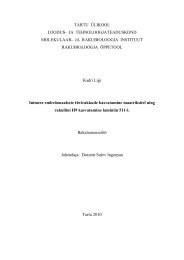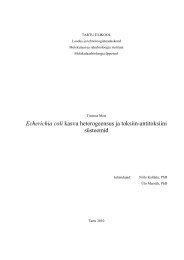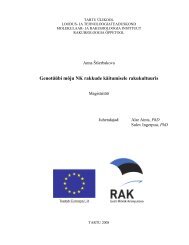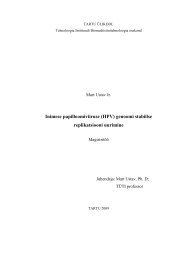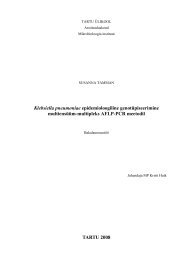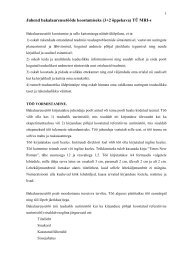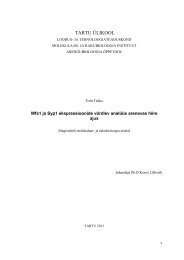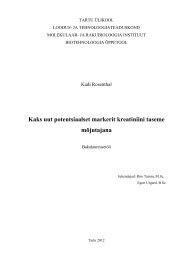GDNF geeni sekveneerimine ja mutatsioonide analüüs ...
GDNF geeni sekveneerimine ja mutatsioonide analüüs ...
GDNF geeni sekveneerimine ja mutatsioonide analüüs ...
- No tags were found...
Create successful ePaper yourself
Turn your PDF publications into a flip-book with our unique Google optimized e-Paper software.
Sequencing and analysis of mutations in the <strong>GDNF</strong> gene inindividuals with congenital kidney anomaliesSummaryKidney anomalies and CAKUT (congenital anomalies of the kidney and urinary tract) arepolygenic diseases which are caused by mutations in many different genes. Recent studieshave shown that mutations in the <strong>GDNF</strong> gene, which is crucial in nefrogenesis, may be one ofmany to cause these kind of diseases. Still the studies carried out have not found the causativemutations responsible for the given diseases.The aim of this study was to find mutations which could be involved in causing congenitalkidney anomalies. In the study, 90 individuals diagnosed with CAKUT and 21 healthyindividuals were selected from the biobank of the Estonian Genome Center of the Universityof Tartu. DNA samples from the selected subjects were sequenced using traditional Sangersequencing, where DNA fragments were amplified by PCR, purified, and sent to the corefacility of the Estonian Biocentre.The sequence fragments were aligned to the reference <strong>GDNF</strong> sequence and analyzed usingthe Sequencher programme (GeneCodes, Inc). Aditionally, mutations called in the <strong>GDNF</strong>gene from sequences generated by long-range PCR and multiplexed second generationsequencing using the HiSeq2000 (Illumina) were analyzed. Both technologies revealed a fewSNPs with frequencies different from those in the NCBI dbSNP database, and several newmutations. The minor allele of several polymorphisms was more frequent in the cases. Thesingle mutations which occurred in more than 10 patients were located in exons, introns andthe 3’UTR.These findings may play a role in the development of CAKUT or other kidney anomalies.However, more research must be done to confirm these discoveries, the number of examinedsubjects should be increased, in order to make proper conclusions.32




